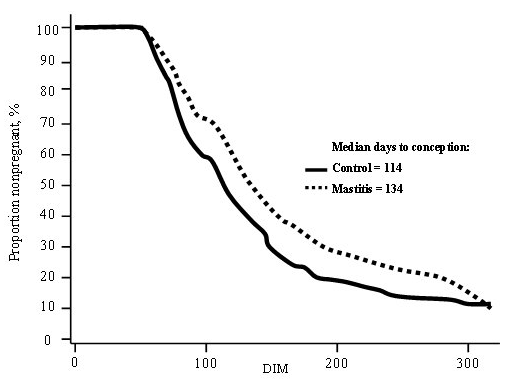



Mastitis and BCS Loss Affects Fertility
Reproductive performance is quickly becoming the biggest challenge in dairy herds’ profitability, according to Ricardo C. Chebel, DVM, MPVM, Department of Veterinary Medicine, University of Minnesota.Most dairymen are quick to recognise reproductive inefficiencies as one of the most important and frustrating challenges in their dairy operations. In 2007, the National Animal Health Monitoring System demonstrated that reproductive inefficiency is second only to mastitis as a cause of involuntary culling (culling other than for low production). Many factors affect the reproductive ability of dairy cows and they are physiological, pathological and managerial in nature.
Pathological factors – Mastitis is perhaps the single most important disease affecting lactating dairy cows because of the economic losses related to lower milk yield, milk discarded, culling, and antibiotic therapy of cows. Another very important consequence of mastitis is reduced reproductive performance. Researchers at the University of Tennessee demonstrated that cows that had clinical mastitis before first postpartum AI (FPAI) had extended calving to AI interval (93.6 vs. 71 days).
Cows that had mastitis between FPAI and pregnancy diagnosis had extended interval from calving to conception (125.2 vs. 92.1 days). In California, it was observed that cows that had mastitis at any time during the lactation had increased incidence of abortions between 42 and 180 days after AI (11.0 vs. 5.8 per cent). As a result, the calving to conception interval was significantly greater for cows that experienced mastitis at any time during the lactation compared to cows that did not have mastitis (Figure 1).
Other studies in Florida and California have further correlated occurrence of mastitis or sub-clinical mastitis (SCC > 200,000 cells/mL and no clinical mastitis) between AI and pregnancy diagnosis to abortion. Therefore, it is obvious that occurrence of mastitis impairs reproductive performance. The inflammatory and immune responses to the intra-mammary infection may affect reproduction by preventing ovulation and resumption of cyclicity after calving, by reducing fertilization rates and embryo development, and by compromising embryonic development and pregnancy establishment and maintenance (i.e. reduced embryonic/fetal survival and increased incidence of abortions).
Managerial factors – Body condition score (BCS, 1 = emaciated, 5 = obese) is a measure of fat storage. Early in lactation, dairy cows mobilise large amounts of body fat to provide energy for milk production because dry matter intake is not sufficient to supply all energy needs. Therefore, it is normal for lactating dairy cows to lose body condition during the first 60 days in milk (DIM), but the BCS during the first 60 DIM and at 60 DIM are correlated with fertility. Cows that lose 1.0 or more BCS units from calving to 60 DIM are more likely to be anovular (40.6 vs. 17.9 per cent) and cows that have BCS < 2.75 at 60 DIM are more likely to be anovular than cows with BCS > 3.0 (27.0 vs. 14.4 per cent).
Furthermore, cows that lose 1.0 or more units of BCS during the first 60 DIM have smaller pregnancy rates after first AI (22.3 per cent) compared with those that lose < 0.75 unit (30.7 per cent) or those that do not lose BCS (35.6 per cent). Similarly, those cows with BCS < 2.75 at 60 DIM have smaller pregnancy rates following first postpartum AI (27.9 per cent) than those with BCS between 3.0 and 3.75 (34.6 per cent) or those with BCS > 4.0 (41.8 per cent). Recently, a study in California with > 7,000 lactations demonstrated that cows that lost BCS during the dry-period (from approximately 60 days before parturition to parturition) were more likely to have retained placenta and metritis, were less likely to be pregnant at 150 DIM, and had an extended calving to pregnancy interval compared with cows that had no change or gained BCS during the dry period. Cows were predisposed to lose BCS during the dry period when BCS at dry-off was > 3.25.
Reproductive failure is a multi-factorial problem and is affected by feed intake, energy balance, peri-parturient disorders, correct AI procedure, semen quality, etc. Reducing the incidence of mastitis is expected to result in improved reproductive performance.
Further, improved reproductive efficiency is expected when BCS loss during the dry period is eliminated and BCS loss during postpartum is minimised. Correct milking procedures, clean stalls and facilities, providing cows with fresh feed and water, and avoiding overcrowding during the close-up and fresh periods are critical to minimise mastitis risk, avoid BCS loss during the dry period, and reduce the extent of BCS loss postpartum.



